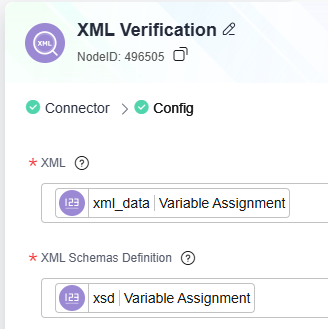XML Verification
The XML verification processor is used to verify and process XML content.
Verification results:
- Successful: No errors are logged, and the composite application flow runs normally.
- Failed: An exception is logged, and the flow task stops.
Note: If an error monitoring processor is used, XML verification failures can be detected and handled according to the error monitoring rules.
Configuring Parameters
|
Parameter |
Description |
|---|---|
|
XML |
XML data to be verified. The value can contain a maximum of 100,000 characters. |
|
XML Schemas Definition |
XSD data to be verified (same as the XML compilation rule). The namespace http://www.w3.org/2001/XMLSchema cannot be changed. |
|
Note: You can select the input parameter by referencing variables. |
|

Feedback
Was this page helpful?
Provide feedbackThank you very much for your feedback. We will continue working to improve the documentation.See the reply and handling status in My Cloud VOC.
For any further questions, feel free to contact us through the chatbot.
Chatbot





